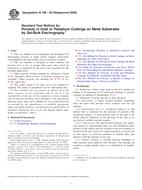Potrebujeme váš súhlas na využitie jednotlivých dát, aby sa vám okrem iného mohli ukazovať informácie týkajúce sa vašich záujmov. Súhlas udelíte kliknutím na tlačidlo „OK“.
ASTM B798-95(2009)
Standard Test Method for Porosity in Gold or Palladium Coatings on Metal Substrates by Gel-Bulk Electrography
Automaticky preložený názov:
Štandardná skúšobná metóda pre Pórovitosť v zlate alebo paládium povlaky na kovové substráty Gel - Bulk elektrografia
NORMA vydaná dňa 1.10.2009
Informácie o norme:
Označenie normy: ASTM B798-95(2009)
Poznámka: NEPLATNÁ
Dátum vydania normy: 1.10.2009
Kód tovaru: NS-8168
Počet strán: 6
Približná hmotnosť: 18 g (0.04 libier)
Krajina: Americká technická norma
Kategória: Technické normy ASTM
Anotácia textu normy ASTM B798-95(2009) :
Keywords:
electrography, gel, gel electrography, gold coatings, gold platings, palladium coatings, palladium platings, plating, porosity, porosity testing, Contamination--coatings, Corrosion--electrodeposited coatings, Defects--coatings, Destructive testing--coatings, Electrical contact materials (gold alloy), Electrodeposited coatings, Electrodeposited gold coatings, Electrography, Exposure tests, Gel-bulk electrography, Noble metal coatings, Palladium alloy electrical contact materials
Doplňujúce informácie
| Significance and Use | ||||||||||||||
|
Noble metal coatings, particularly gold or palladium, are often specified for the contacts of separable electrical connectors and other devices. Electrodeposits are the form of gold or palladium which is most used on contacts, although gold and palladium are also employed as clad metal and as weldments on the contact surface. The intrinsic nobility of gold and to a certain extent palladium enables them to resist the formation of insulating films that could interfere with reliable contact operation. In order that the nobility of gold be assured, porosity, cracks, and other defects in the coating that expose base metal substrates and underplates must be minimal or absent, except in those cases where it is feasible to use the contacts in structures that shield the surface from the environment or where corrosion inhibiting surface treatments for the deposit are employed. The level of porosity in the coating that may be tolerable depends on the severity of the environment to the underplate or substrate, design factors for the contact device like the force with which it is mated, circuit parameters, and the reliability of contact operation that it is necessary to maintain. Also, when present, the location of pores on the surface is important. If the pores are few in number or are outside of the zone of contact of the mating surfaces, their presence can often be tolerated. Methods for determining pores on a contact surface are most suitable if they enable their precise location and numbers to be determined. Contact surfaces are often curved or irregular in shape, and testing methods should be suitable for them. In addition, the severity of porosity-determining tests may vary from procedures capable of detecting all porosity to procedures that detect only gross defects. The test method in this document is generally regarded as severe. The relationship of porosity levels revealed by particular tests to contact behavior must be made by the user of these tests through practical experience or judgment. Thus, absence of porosity in the coating may be a requirement for some applications, while a few pores in the contact zone may be acceptable for others. This test method is capable of detecting porosity or other defects in gold or palladium coatings that could participate in substrate corrosion reactions. In addition, it can be used on contacts having complex geometry such as pin-socket contacts (although difficulty may be experienced in inspecting deep recesses). |
||||||||||||||
| 1. Scope | ||||||||||||||
|
1.1 This test method covers equipment and techniques for determining porosity in noble metal coatings, particularly electrodeposits and clad metals used on electrical contacts. 1.2 The test method is designed to show whether the porosity level is less or greater than some value which by experience is considered by the user to be acceptable for the intended application. 1.3 Other porosity testing methods are outlined in Guide B 765. Detailed critical reviews of porosity testing are also available. Other porosity test methods are B 735, B 741, B 799, and B 809. 1.4 The values stated in SI units are to be regarded as standard. The values in parentheses are for information only. 1.5 This standard does not purport to address all of the safety concerns, if any, associated with its use. It is the responsibility of the user of this standard to become familiar with all hazards including those identified in the appropriate Material Safety Data Sheet (MSDS) for this product/material as provided by the manufacturer, to establish appropriate safety and health practices, and determine the applicability of regulatory limitations prior to use. For specific hazard statements, see Sections 7 and 8. |
||||||||||||||
| 2. Referenced Documents | ||||||||||||||
|




 Cookies
Cookies
